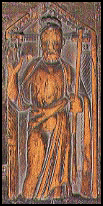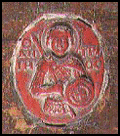 |
| Pict. 37 Apostle Peter, ivory, 6th century. Detail from 36. |
 |
| Pict. 38 Saint Demetrios, cameo from glassware, 12th century. Detail from 36. |
|
In the same type of micro-sculpture we can include a group of crosses for blessing and consecrating which consist of a
small wood-carved nucleus held together in a metallic frame. In the middle of each side there are representations of the
Crucifixion and the Birth or the Babtism of Christ flanked by other scenes from the life of Christ or the Virgin. The frame
is covered with gold-threaded, speckled or spotted jewels, enamels, corals. turquoise, pearls, amber and glassware stones.
In addition angels, dragons, little domes with crescents and pigeons, lotus-shaped anthemia, roses, and tulips enrich the
ornamentation. From the middle of the 18th and the whole of the 19th century the external decorative work increased so
much that it mostly covers and hides the wood-carved nucleus of the cross.
|





